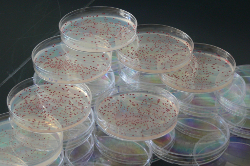
The most successful E. coli strains in a long-term evolution experiment were those that showed the greatest potential for adaptation
By Jef Akst
Natural selection picks the most well adapted organisms to survive and reproduce. But what if the most beneficial mutations in the short term meant less room for adaptation in the future?
New research suggests that the capacity of a species to further adapt to its environment, or evolvability, can be just as important, or more so, than the adaptations it's already acquired. The results, published this week in Science, give an empirical foundation to a theory that, in addition to beneficial mutations that confer immediate fitness advantages, long-term evolvability may be important for determining a species' success.
"[The idea of] selection for evolvability has been in the air for a long time, but this is one of the first real systematic and explicit demonstrations of this actually happening," said evolutionary biologist and population geneticist Michael Desai of Harvard University, who was not involved in the study.
Researchers at Michigan State University and the University of Houston in Texas took advantage of a long-term evolution experiment on Escherichia coli that's been running for more than 50,000 generations. Characterizing archived strains from 500, 1000, and 1500 generations, the team identified two beneficial mutations that arose in some strains prior to 500 generations and eventually spread through the entire population. The researchers dubbed the strains that carried these mutations at 500 generations the eventual winners (EWs) and those lacking the mutations the eventual losers (ELs).
The first surprise came when the team compared the fitness of four strains -- two EWs and two ELs -- and found that while all four strains had significantly higher fitness than the ancestral strain, the ELs appeared more fit than the EWs. Comparing the four strains directly confirmed the result: The two EW strains were at a significant disadvantage to the ELs. If these strains had not accumulated any more mutations, the researchers estimated the EWs would have gone extinct in just 350 additional generations.
But it wasn't just evolutionary luck that allowed the EWs to prevail over the ELs. When the researchers "replayed" evolution by culturing 10 replicate populations for each of the four strains for 883 generations, the EW populations almost always came out on top, acquiring more beneficial mutations that allowed them to overcome their fitness disadvantage to the ELs. The results suggested that the EWs, while initially at a disadvantage, prevailed in the long-term because they were more likely to acquire more beneficial mutations. In other words, the EWs had greater evolvability.
"It's exciting to see some evidence that this sort of thing, which everyone has been speculating about," Desai said. "The question is how common are these sort of interactions."
The large population sizes used in this study reduced competition between strains, allowing the less fit EWs to stick around long enough to accumulate the mutations that would eventually give them a fitness advantage. And the laboratory conditions in which the bacteria were held were unnaturally constant. Resource availability and environmental variation could affect the likelihood that evolution will select for strains on the basis of their evolvability.
"Whether natural populations can really select on those differences in evolvability will depend on a lot of things that we don't understand," said Desai. "But the point is that such differences in evolvability exist."
The researchers didn't find any changes in overall mutation rate among the strains, but proposed that the differences in evolvability may be due to interactions between the mutations that existed at the start of the replay experiments and those that later evolved. A mutation called topA1 in the EL strains, for example, which affects an enzyme involved in winding and unwinding DNA, appeared to dampen the fitness advantage of a subsequent mutation in the spoT gene, which encodes a global regulator of gene expression. While the spoT mutation conferred a significant fitness advantage to the EW strains that lacked the topA1 mutation, it had no significant effect on the EL strain, possibly due to the changes in DNA supercoiling that resulted from the EL mutation in topA.
"It's a pretty exciting result," said evolutionary biologist Paul Turner of Yale University, who did not participate in the study. "Evolutionary biology is not generally known as a predictive science," he said, noting the exception that scientists have used historical data on the success of flu virus lineages to predict which strains to target with the vaccine for the following year. "Maybe a study like this helps us do this in a more generalized way."
R.J. Woods et al., "Second-order selection for evolvability in a large Escherichia coli population," Science, 331: 1433-6, 2011.
No comments:
Post a Comment